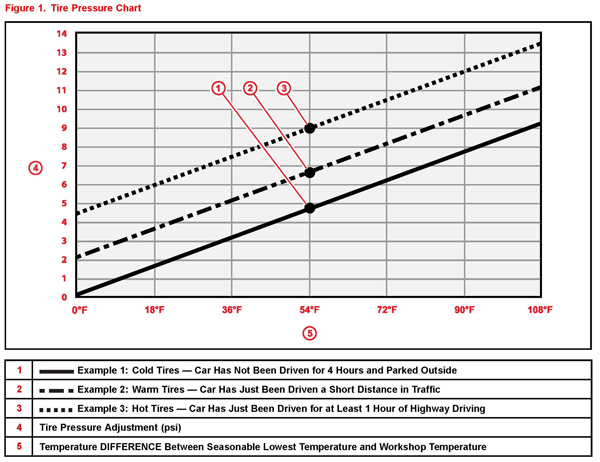Seasonal temperature change can dramatically alter tire pressure, which can cause the tire pressure warning lamp to illuminate. This bulletin applies to some 2004 – 2007 model year Toyota vehicles with direct TPWS and all 2008 and newer model year Toyota vehicles.
Tire temperature is dependent on “cold” tire pressure, driving distance and speed, ambient temperature and road surface temperature. As the temperature of the tire changes, air in the tire expands and contracts, changing the tire’s air pressure. The cold tire pressure for all models will vary and will need to be adjusted accordingly.
“Cold” tire pressure, as shown on the tire pressure label on our vehicles, is generally considered to be the pressure in a tire that has not been driven in the past 4 hours and has been parked outdoors.
The TPWS MUST be initialized with the tire pressure marked on the vehicle placard. Tires are then adjusted according to the information in this bulletin to ensure that the TPWS light does not illuminate unnecessarily.

Example 1: Temperature Compensation – “Cold” Tires
The vehicle has been parked overnight outside shop (vehicle has “cold” tires) and tire pressures are set to 31.9 psi. Shop temperature is 68°F and expected lowest ambient temperature in the local area is to be 14°F. Subtract the expected lowest temperature (14 F) from the shop temperature (68°F) = 54°F.
Using the tire pressure chart, find the intersection of the cold tire line at the point corresponding to 54°F and read oft the value on the tire pressure change axis. In this case, it would be about 4.9 psi.
The tires should be filled to:
31.9 + 4.9 psi = 36.8 psi
Example 2: Temperature Compensation – "Warm" Tires
The vehicle has been driven to the shop on surface streets for about 30 minutes (vehicle has “warm” tires) and tire pressures are set to 31.9 psi.
Shop temperature is 68 F and expected lowest ambient temperature in your area is to be 14°F. Subtract the expected lowest temperature (14°F) from the workshop temperature (68°F) = 54°F.
Using the Tire Pressure Chart, find the intersection of the warm tire line at the point corresponding to 54°F and read off the value on the tire pressure change axis. In this case, it would be about 6.7 psi.
The tires should be filled to:
31.9 + 6.7 psi = 38.6 psi
Example 3: Temperature Compensation – “Hot” Tires
The vehicle has been driven to the shop on the highway for at least 60 minutes (vehicle has “hot” tires) and tire pressures are set to 31.9 psi.
Shop temperature is 68°F, and the expected lowest ambient temperature in the area is expected to be 14°F. Subtract the expected lowest temperature (14°F) from the shop temperature (68°F) = 54°F.
Using the tire pressure chart, find the intersection of the hot tire line at the point corresponding to 54°F, and read off the value on the tire pressure change axis. In this case, it would be about 9.0 psi.
The tires should be filled to:
31.9 + 9.0 psi = 40.9 psi
Courtesy of Toyota.












